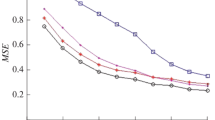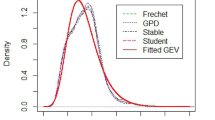Abstract
The constructed estimator is introduced for the right truncation point of the truncated exponential distribution. The new estimator is most efficient in important ranges of truncation points for finite sample sizes. The introduced inverse mean squared error clearly indicates the good behaviour of the new estimator. The estimation of the scaling parameter is considered in all discussions and computations. The methods and models of the extreme value theory are not appropriate to estimate the truncation point because they work only in the case of very large sample sizes. Furthermore, a procedure for a first goodness-of-fit test is introduced. All this has been researched by extensive Monte Carlo simulations for different truncation points and sample sizes. Finally, the new inference methods are applied at the end for the random distribution of wildfire sizes and earthquake magnitudes.




Similar content being viewed by others
References
Bayrak Y, Öztürk S, Cinar H, Koravos GC, Tsapanos TM (2008) Regional variation of the ω–upper bound magnitude of GIII distribution in and around Turkey: Tectonic implications for earthquake hazards. Pure Appl Geophys 165:1367–1390
Beauval C, Scotti O (2004) Quantifying sensitivities of PSHA for France to earthquake catalog uncertainties, truncation of ground-motion bariability, and magnitude limits. Bull Seismol Soc Am 94:1579–1594
Beg MA (1982) Optimal Tests and Estimators for Truncated Exponential Families. Metrika 29:103–113
Beirlant J, Goegebeur Y, Segers J, Teugels J (2004a) Statistics of extremes—theory and application. Wiley series in probability and statistics. John Wiley, Chichester
Beirlant J, Goegebeur Y, Segers J, Teugels J (2004b) Statistics of extremes—theory and application. http://lstat.kuleuven.be/Wiley/. Accessed date Dec 2009
Christopeit N (1994) Estimating parameters of an extreme value distribution by the method of moments. J Stat Plan Inference 41:173–186
Cooke P (1979) Statistical inference for bounds for random variables. Biometrika 66:367–374
Cosentino P, Ficarra V, Luzio D (1977) Truncated exponential frequency—magnitude relationship in earthquake statistics. Bull Seismol Soc Am 67:1615–1623
Cumming SG (2001) A parametric model of the fire-size distribution. Can J For Res 31:1297–1303
Dargahi-Nourbary GR (1983) A procedure for the estimation of the upper bound for earthquake magnitudes. Phys Earth Planet Inter 33:91–93
de Haan L, Ferreira A (2006) Extreme value theory—an introduction, Springer series in operations research and financial engineering. Soringer, USA
Deemer WL, Votaw DF (1955) Estimation of parameters of truncated or censored exponential distributions. Ann Math Stat 26:498–504
Dixit UJ, Nasiri PN (2006) Estimation of parameters of a right truncated exponential distribution. Stat Pap 49:225–236
Greenwood JA, Landwehr JM, Matalas NC, Wallis JR (1979) Probability weighted moments: definition and relation to parameters of several distributions expressible in inverse form. Water Resour Res 15:1049–1054
Gutenberg B, Richter CF (1941) Seismicity of the earth. Geol Soc Am Spec Pap 34:1–131
Gutenberg B, Richter CF (1954) Seismicity of the earth and associated phenomena, 2nd edn. Princeton University Press, Princeton
Hanks TC, Kanamori H (1979) A moment magnitude scale. J Geophys Res 84:2348–2350
Hannon PM, Dahiya RC (1999) Estimation of parameters for the truncated exponential distribution. Commun Stat Theory Methods 28:2591–2612
Hosking JRM, Wallis JR (1987) Parameter and quantil estimation for the generalized Pareto distribution. Technometrics 27:251–261
Hosking JRM, Wallis JR, Wood EF (1985) Estimation of the generalized extreme-value distribution by the method of probability-weighted moments. Technometrics 29:339–349
Kijko A (1983) A modified form of the first Gumbel distribution: model for the occurrence of large earthquakes, part II: estimation of parameters. Acta Geophysica 31:27–39
Kijko A (2004) Estimation of the maximum earthquake magnitude mmax. Pure Appl Geophys 161:1655–1681
Kijko A, Graham G (1998) Parametric-historic procedure for probabilistic seismic hazard analysis part I: estimation of maximum regional magnitude mmax. Pure Appl Geophys 152:413–442
Leadbetter MR, Lindgren G, Rootzén H (1983) Extremes and related properties of random sequences and processes. Springer, New York
Mueller S (2010) The influence of maximum magnitude on seismic-hazard estimates in the Central and Eastern United States. Bul Seismol Soc Am 100:699–711
Nordquist JN (1945) Theory of largest values applied to earthquake magnitudes. Trans Am Geophs Union 26:29–31
Page R (1968) Aftershocks and micro aftershocks of the great Alaska earthquake of 1964. Bul Seismol Soc Am 58:1131–1168
Pisarenko VF (1991) Statistical evaluation of maximum possible earthquake. Phys Solid Earth 27:757–763
Pisarenko VF, Lyubushin AA, Lysenko VB, Golubeva TV (1996) Statistical estimation of seismic hazard parameters: maximum possible magnitude and related parameters. Bul Seismol Soc Am 86:691–700
Pisarenko VF, Sornette A, Sornette D, Rodkin M (2008) New approach to the characterization of Mmax and of the tail of the distribution of earthquake magnitudes. Pure Appl Geophys 165:847–888
Quenouille MH (1956) Notes on bias in estimation. Biometrika 43:353–360
Raschke M (2009) The biased transformation and its application in Goodness-of-fit test for the gamma and beta distribution. Commun Stat Comput Simul 9:1870–1890
Raschke M (2010) Empirical behaviour of tests for the beta distribution and their application in environmental research. Stoch Environ Res Risk Assess. doi:10.1007/s00477-010-0410-3
Réyni A (1953) On the theory of order statistics. Acta Mathematica Academiae Scientarium Hungaricae 4:191–232
Robson DS, Whitlock JH (1964) Estimation of a truncation point. Biometrica 5(1):33–39
Sheikha AK, Boahb JK, Younasa M (1989) Truncated extreme value model for pipeline reliability. Reliab Eng Syst Saf 25:1–14
Stephens MA (1986) Tests based on the EDF statistics. In: D’Agostino RB, Stephens MA (eds) Goodness-of-fit techniques. Marcel Dekker, New York
Sukhatme PV (1937) Tests of significance for samples of χ2-population with two degrees of freedom. Ann Eugen 8:52–56
Tate RF (1959) Unbiased estimation: function of location and scale parameters. Ann Math Statist 30:331–366
Tuncel M, Yegulap M, Kuo JT (1974) Statistical prediction of the occurrence of maximum magnitude earthquakes. Bul Seismol Soc Am 64:393–414
Acknowledgement
The author thanks S.G. Cumming for providing wildfire data.
Author information
Authors and Affiliations
Corresponding author
Appendix
Appendix
See Tables 2, 3, 4, 5, 6 7, 8 and 9.
Rights and permissions
About this article
Cite this article
Raschke, M. Inference for the truncated exponential distribution. Stoch Environ Res Risk Assess 26, 127–138 (2012). https://doi.org/10.1007/s00477-011-0458-8
Published:
Issue Date:
DOI: https://doi.org/10.1007/s00477-011-0458-8




